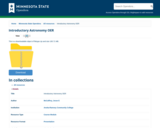
Open presentation on introductory astronomy.
- Subject:
- Astronomy
- Physical Science
- Material Type:
- Lesson
- Provider:
- Minnesota State Opendora
- Author:
- Jesse E McCaffrey
- Date Added:
- 12/01/2020

Open presentation on introductory astronomy.

This text includes 25 reading assignments for an introductory astronomy course. They have been modified from the OpenStax Astronomy 2e and College Physics 2e (linked in related resources below) textbooks to order the topics in a logical manner for a one semester course and provide shortened (~10-20 pages) readings intended for biweekly reading assignments. The text also features enhanced treatment of the Newton's Laws, Energy, and Optics content that go beyond the typical introductory astronomy course for non-majors.
Course connections: This content was built for an introductory survey of astronomy course (e.g., PHYS 103), including apparent motions of objects in the sky, light, telescopes, solar system objects, exoplanets, the sun, stars, galaxies, and cosmology. Basic math skills (arithmetic, powers, scientific notation, unit conversions) will be used frequently. This course is designed for students in all majors.
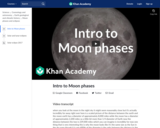
The Moon and the sun look roughly the same size in the sky because although the sun’s diameter is ~400 times greater than the Moon’s, the sun is ~400 times farther away from the Earth as the Moon is! The Moon goes through phases because as it rotates around the Earth, different parts of the Moon are made visible to us from the sun’s light. Created by Sal Khan.
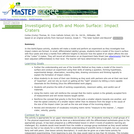
In this activity students use a simple model of the moon to do an experiment to see how impact craters are formed. The lesson worksheets are differentiated and students are put into pre-determined teams by ability to conduct the experiment.
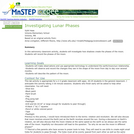
This activity is a lab investigation where students design their own lunar phases model using household materials.
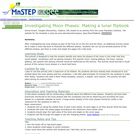
This activity is a reinforcement activity where students will make a flipbook of the lunar phases.
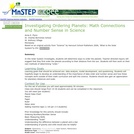
This set of activities is designed to help students develop an understanding of scale/distance and ordering the planets from the sun, understanding Earth's position in the solar system, and developing new ways of determining "order."
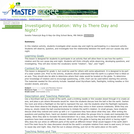
This is a classroom activity in which students will observe, question, and investigate the relationship between the sun and the earth and how that relationship causes day and night.

The University of Iowa Center for Global and Regional Environmental Research and College of Education teamed up to develop free eighth grade science curricula on land use and climate science, in response to Iowa’s grade level alignment of the middle school Next Generation Science Standards.
Primary author Dr. Ted Neal, clinical associate professor of science education, led a team of graduate and pre-service teaching students and CGRER scientists to develop the material. They grouped standards, resources and lesson material into six bundles, each designed to engage Iowa’s middle schoolers with local data and information on relevant topics like athletic concussions and agriculture.
These lessons are built on NGSS principles and put learning in the students’ hands with hands-on activities for groups and individuals. Kids will have ample opportunity to get curious, generate questions and lead themselves to answers.

In this activity, students identify spirals and other shapes present in nature and discuss at what sizes or scales these shapes exist. Examples include a hurricane, foraminifera, nautilus, and a galaxy. They will discuss the differences and similarities of each of these spirals and investigate the powers of ten that identify the scales at which these different examples exist.

This experiment uses the heating of water to explore the concepts of density and volume. Students learn about the transfer of heat energy within the atmosphere, hydrosphere, and Earth's interior, and connect this transfer to differences in density, which in turn result in motion. As part of the investigation, students will also become familiar with the Celsius and Fahrenheit temperature scales.
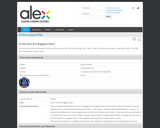
Young students may think the sun is the biggest and brightest star in the universe since it appears to be the brightest star in the sky when viewed from Earth. In this lesson, students will use flashlights to construct a model of the difference in stars' appearances due to their distance from Earth. Then they will use the Internet to research the sun and stars to create a poster, picture book, or digital presentation to explain that the sun is not the biggest or brightest star--it only appears that way due to its proximity to Earth. This lesson results from a collaboration between the Alabama State Department of Education and ASTA.

In this activity, students organize a set of fossils chronologically and learn to correlate, based on fossil evidence, the stratigraphy of one location with that of an adjacent location. Earth Science Reference Tables are used to identify the epoch of occurrence and the age of each of the fossil specimens. Students will become familiar with the concept of index fossils and understand what makes a good index fossil.

The source files for the javasript project for studentspowerpoint slides CCBY license - use, modify etc, for attribution please include Clayton State University and ALG https://www.affordablelearninggeorgia.org/

Our Solar SystemThis is a YouTube video/link of a unit I created using Canva. The video is a read aloud of Pluto and the Planets. There are 5 student led activities at the end with ways to assess each activty. Essential questions are included in addition to possible student questions, and teacher inquiry questions. Also, there are additional texts that can be incorporated into the lessons as well.
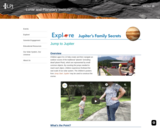
Children ages 8 to 13 help create and then navigate an outdoor course of the traditional "planets" (including dwarf planet Pluto), which are represented by small common objects. By counting the jumps needed to reach each object, children experience firsthand the vast scale of our solar system. The children's posters from Jump Start: Jupiter! may be used to construct the course.
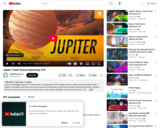
Jupiter is the biggest planet in our solar system. The gas giant is NOT a failed star, but a really successful planet! It has a dynamic atmosphere with belts and zones, as well as an enormous red spot that’s actually a persistent hurricane. Jupiter is still warm from its formation, has an interior that’s mostly metallic hydrogen, and may not even have a core.
Chapters:
Introduction: Jupiter
Jupiter's Clouds: Zones & Belts
Jupiter's Great Red Spot
Jupiter's Structure
Is Jupiter a Failed Star?
Jupiter Radiates Heat
Jupiter's Strong Magnetic Field
Jupiter's Gravity
Review
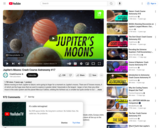
Before moving on from Jupiter to Saturn, we’re going to linger for a moment on Jupiter’s moons. There are 67 known moons, 4 of which are the huge ones that we want to explore in greater detail. Ganymede is the largest - larger, in fact, than any other moon in the solar system and the planet Mercury! Callisto, orbiting the farthest out, is smaller but quite similar to Ganymede in many ways. Io, meanwhile, is most noteworthy for its tremendous volcanic activity. There’s also water on Ganymede and Europa!
Chapters:
Introduction: Jupiter's Moons
Ganymede: Jupiter's Largest Moon
Callisto: Jupiter's Second Largest Moon
Io: Volcanoes!
Europa: The Ocean Moon
The Habitable Zone
Jupiter's Other Moons
Review
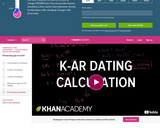
Working through a calculation for K-Ar dating (good to have some prior experience with e and logarithms). Created by Sal Khan.

In this final lesson of the Dancing Lights curriculum, students will reflect on and discuss what they learned about the aurora. First, students will compare what they know now with what they knew at the beginning of the program, and discuss their answers with a partner using Think, Pair, Share. The entire class will create a new KWL (Know/Want-to-know/Learned) chart on the board before turning in their individual work.